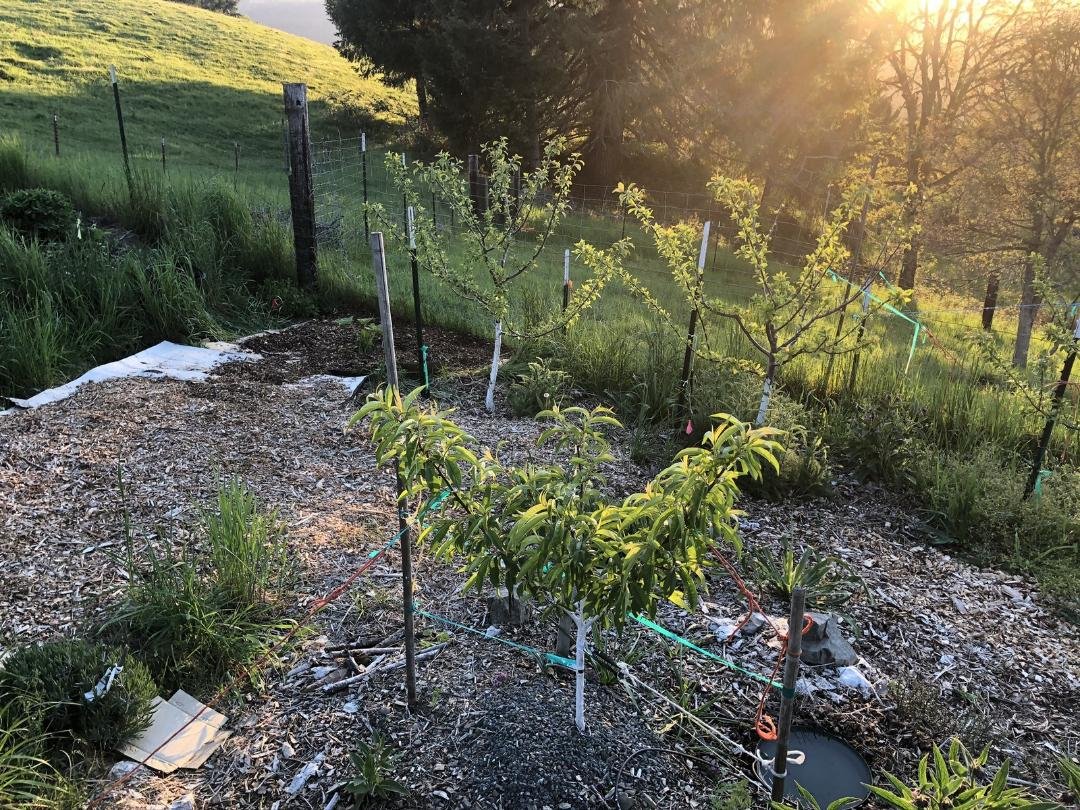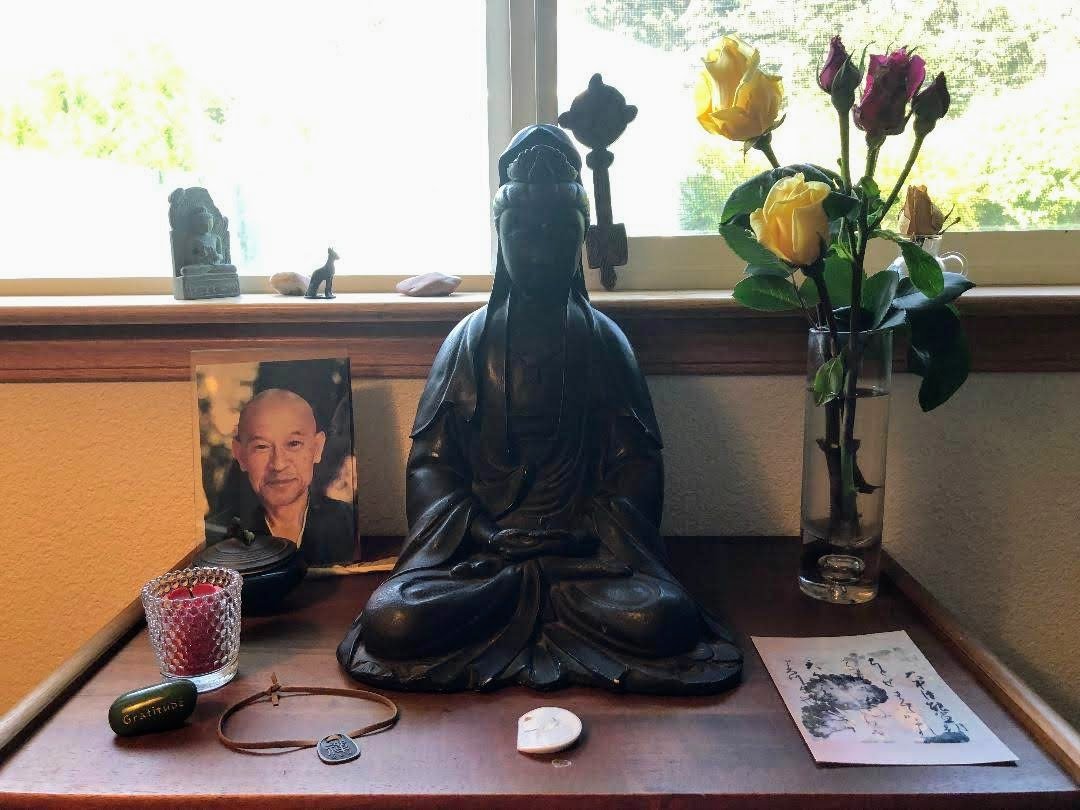
Expressions of Home Altars
Having a home altar can provide support to your practice as a focal point for your sitting area. For many, home altars have taken on new meaning as we practice at home and online.
Altars vary in shapes and sizes, as well as locations; they may even be outdoors. Home altars can include the traditional candle, scented material, flowers and a statue, or may be any simple arrangement that is meaningful to you.
These are some of the home altars of the Arcata Zen Group sangha. We thank those who are sharing their cherished spaces with the community and hope they bring you joy and inspiration. Please contact us if you would like a photo of your altar to be included.
Chris B.
The altar items rest on a redwood round from a tree recently cut down on AZG temple grounds. This to me feels to be a very important essence of the altar itself. Laying in front of the base of the altar is a rock cairn, in this case a reminder of navigation that just one step back and the Dharma lies in all directions. These rocks come from the coffee creek in Trinity County. Above the altar to the right is a ornamental fish, and hooks. The fish reminds me to not swim in my thoughts, a reminder to allow my thoughts to pass freely as a fish. The hooks remind me to not get hooked by my unskillful habitual ways. Above the altar is a empowered healing blanket from Grandmaster Fu. Which includes two rows of balanced healing magnetic buttons, two empowering mantras, six symbols, and regenerative universal energy given by the empowerment process by Grandmaster Fu. Altar center is a picture of Suzuki Roshi that Beverly gifted me after receiving jukai ceremony. Also on the altar are offering dishes, a candle, and symbols of stability and compassion. In the foreground are my three bells, and chant book for morning practice. Just off the image to my left is my web cam, and a monitor for hybrid zoom zazen. At the top right lies a safe resting place for my rakusu!
This altar lies in a corner of my apartment referred to as Owen's corner. My tea table made out of a redwood slab, with a driftwood base also lies in this corner. Owen's corner is a very special place for me.
David G.
David L.
Gene B.
Karen M.
The figure above the altar is Golden Tara thankgha with 108 golden taras (female Buddhas). The Buddha in the center of the altar is holding his hands in the gesture of “Fear Not”. The little blue and white calligraphy in front of the Buddha is a Chinese prayer to Amitabha Buddha that all beings who die in these times, may die peacefully and be reborn in a Pure Land. The fan behind the Buddha is a reference to the story at the end of the Genjo Koan and a reminder that some effort is required. The figure at the Buddha’s left hand is a Chinese version of Manjushri, shown as a young man serenely riding on the back of the lion of delusion. The figure to the Buddha's right is a Nepalese version of Avalokiteshvara. The calligraphy on the wall is the four great vows and the pouch suspended below contains the blood vein document received from Reb Anderson as part of the jukai ceremony.
Lesley B.
Here is a picture of my home altar from back when the clematis were blooming. It includes a piece of driftwood with a heart-shaped cutout.
Lindsey H.
My altar is an orchard. The fruit trees represent the ancestors. This little peach tree, called Fei Tao (“fat peach”), is a 450-year-old variety from the Shandong province of northern China. Behind the peach are some greengage plums who trace their 500+ year lineage through America, England, France, Italy and finally to Iran. I love that a particular variety continues to exist because someone from each generation fell in love with it. Grafting a fruit tree to maintain a particular variety is not unlike the succession of ancestors - warm hand to warm hand. The round dish of water under the peach tree is an offering to all the animals that come through the orchard, including the thirsty rattlesnake that shows up in late summer. I learned about skillful means from the rattlesnake last year when I tried to herd it with a stick, then by tossing small pebbles near its tail. The water dish reminds me that all beings, including rattlesnakes, are teachers. It is not always fresh grass and golden light in the orchard though. There are insect outbreaks, disease, snowstorms, heat waves, and predators. The orchard-altar demands perseverance, patience, and endlessly repeated attempts at the cultivation of life.
Lynda M.
These pictures of my home altar include pictures of Green Tara, Avalokitesvara, and a statue of a Buddha from Thailand.
Maggie S.
On the wall are the Paramitas, a scroll with a calligraphic quotation about Light that was a Jukai present, a poem by W.S. Merwin and a reminder, "Whatever has the nature of arising has the nature of ceasing," also a present. On the altar: Quan Yin, Jukai gift from Gael Hodgkins; AZG "Beginners' Handbook;" alarm clock and bell. At Quan Yin's feet, a prize from a fortune cookie: If you can't excel with talent, triumph with effort.
Mark P.
This is small-scale model of the altar at Rinshin- ji. I made it to show Maylie before I built the big one.
Milli and Michael Q.
The central figure is a statue of Kuan Yin. Also on the altar are: a picture of Suzuki Roshi, a candle, flowers, an incense holder given to us when we had our Jukai ceremony in 2004. On the window sill from left to right are: a Buddha statue from India, an Egyptian cat that was on the altar of our daughter, Jessica, who died in 2015, a stone and a wooden Ethiopian cross.
Robert W.
This is my home altar. It has a healing Buddha that I purchased when my wife was going through some health issues and I did not practice much with our Sangha. Now my wife is doing much better and I am back! I also made the maple table for my wife.
Sylviane L-B.
This is where I sit everyday for my morning meditation, facing the altar below the window sill. That small space in front of a window provides me the opportunity to connect with other sentient beings who are also meditating in different places, but we are all together, breathing in, breathing out, trying to let go.
Teresa G.
Above is one of the many small altars, this one located on a dresser top, in my studio apartment. I have little Buddha statues placed everywhere, even in the bathroom, as they keep me connected to what’s important.
On this altar, there is a Kuan Yin statue, some flowers, a picture of Suzuki Roshi, the calligraphy “Beginner’s Mind” by Suzuki Roshi, and my favorite incense (Shoyeido’s Evening Zen). I can see this altar from my bed, which is really nice.














